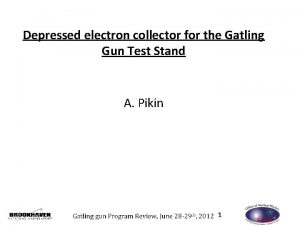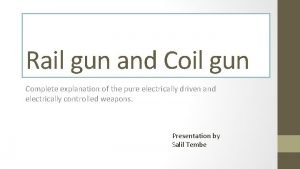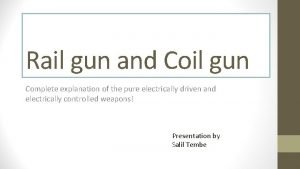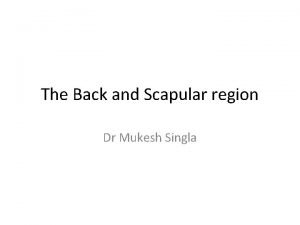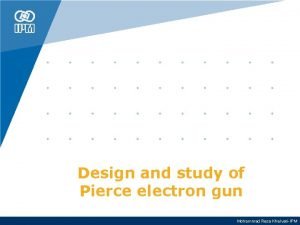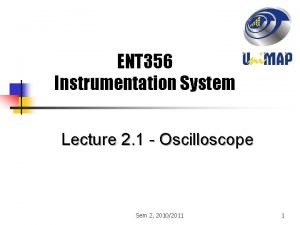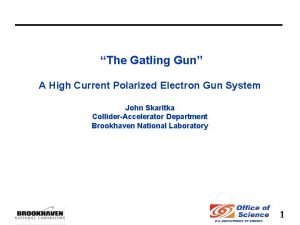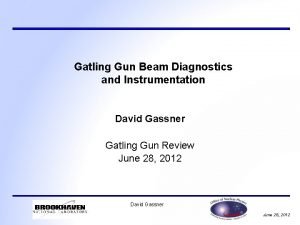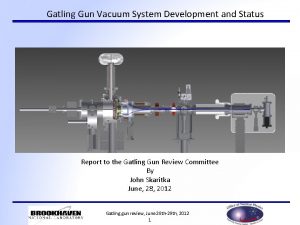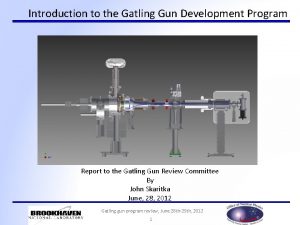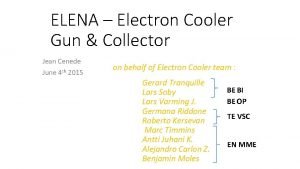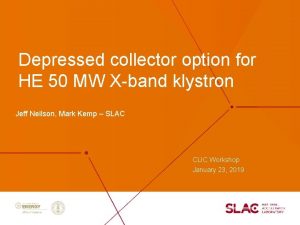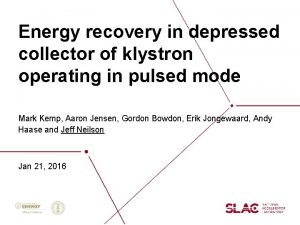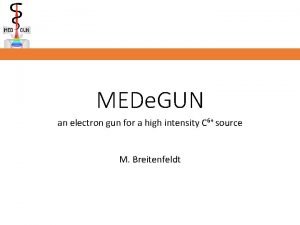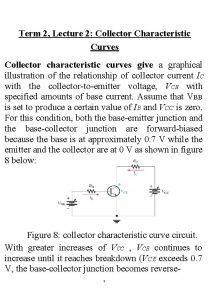Depressed electron collector for the Gatling Gun Test












- Slides: 12

Depressed electron collector for the Gatling Gun Test Stand A. Pikin 6/27/2012 1

Outline 1. Goal of the depressed electron collector development 2. High voltage structure of the Gatling Gun test bench 3. Design layout of the electron collector 4. Electric field distribution and analysis 5. Trajectory simulations of the primary, secondary and backscattered electrons 6. Conclusion 6/27/2012 2

The problem Electron current loss consequences: - Power load on the gun PS (requirement for higher load current ) - Vacuum degradation, ion bombardment and poisoning of the cathode - Provoking HV discharges Goal: -Transmit all primary electrons from the cathode to the electron collector (EC) with minimum possible energy (energy recovering). - Lock all secondary and backscattered electrons within the EC volume (electron black box). - Restrict vacuum conductance between EC and the beam pipe. - Provide a separate vacuum pumping of the EC volume. 6/27/2012 3

HV structure of the Gatling Gun test bench with depressed electron collector 6/27/2012 4

Depressed electron collector design layout Optical solution: - To disperse electrons on the cylindrical surface by slowing down the electron beam at the entrance into the collector diaphragm, - Create radial electric field, which pushes the secondary electrons to the cylindrical surface and scatters transversely the backscattered electrons, - Create axial electric field at the exit from the collector, turning the slow electrons back to the EC volume 6/27/2012 5

Electric field Simulated maximum electric field on a negative electrode: Emax=3. 70 k. V/mm Kilpatrtic’s breakdown electric field: Emax. Kilpatrik=7. 88 k. V/mm Safety factor: = Emax. Kilpatrik/Emax=2. 13 6/27/2012 6

Trajectory simulations: primary electrons, sufficient EC voltage Iel=2 m. A, Eel=250 ke. V ± 10 ke. V, Ntraj=500, r_beam=20. 0 mm, εtransverse=0. 0 mm*mrad (parallel beam), Bmag. Lens= Ureflector=Usuppressing ring=-5 k. V (with respect to the cathode) a. UEC=20 k. V (Sufficient collector voltage) Energy spectrum of primary electrons 70 60 50 dn/de 40 30 20 10 0 230. 0 250. 0 Electron energy, ke. V Returned current of primary electrons: 1. 2 E-4 m. A 6/27/2012 7 270. 0

Trajectory simulations: primary electrons, not sufficient EC voltage b. Not sufficient collector voltage: UEC=0. 0 k. V with respect to the cathode Efficiency of electron collection Dependence of the transmission efficiency on the collector voltage: With collector voltage larger than the full electron energy spread, all electrons are confined within EC volume 6/27/2012 (IStart-Ireturned)/Istart 1. 00 -10. 00 0. 90 0. 80 0. 70 0. 60 0. 50 0. 40 0. 30 0. 20 0. 10 0. 00 10. 00 U_col, k. V 20. 00 8 30. 00

Energy spectrum of the secondary and backscattered electrons Coefficient of secondary electron emission: Ksec=2. 0 - 0. 15 (Energy 0. 4 – 10 ke. V). Used: Ksec=1. 5 Coefficient of backscattering: KBSE=0. 3 (Cu). Used: KBSE=0. 3 6/27/2012 9

Trajectory simulations: secondary particles 2. Secondary electrons (Esec=0. 0 – 50. 0 e. V): N traj=500, Nreturned=0 3. Backscattered electrons (Ebackscat=0. 9*Eprim): N traj=500, Nreturned=0 6/27/2012 10

Magnet control a. For efficient injection of the electron beam into the electron collector the peak field of the magnet lens needs to be 40 – 100 Gs (1200 – 2500 Ax. T). b. The saddle dipole coils can share their axial position with the lens coil. c. Both coils (lens and set of dipole coils) should be compatible with high temperature bakeout of the beam pipe. 6/27/2012 11

Conclusion: 1. The presented solution for the electron collector allows use of a low-power HV power supply 2. The energy of the primary electrons hitting the surface of the electron collector is reduced to the value, close to the electron energy spread 3. With collector voltage higher than the primary electron energy spread the returned primary electron current does not exceed 0. 1% of the primary electron beam current 4. The penetration of the secondary and backscattered electrons into the beam pipe is completely eliminated 5. The electron collector is equipped with a reduced entrance aperture and autonomous NEG pump, which provide efficient vacuum separation of the electron collector from the beam pipe and the electron gun 6/27/2012 12
